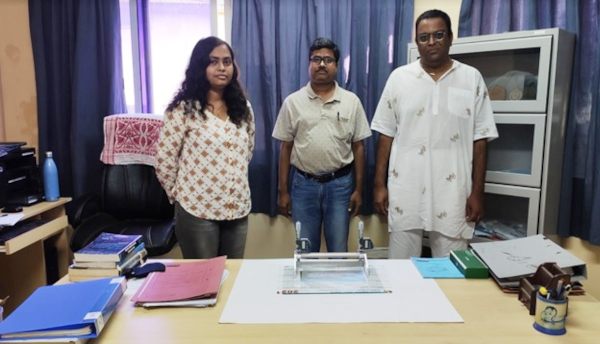Cotton wool, lint, and gauzes are commonly used wound dressing materials. They are often deployed to manage the wound exudates and accelerate the healing process. However, a major disadvantage of such materials is the concerning painful removal exercises that can even damage a healed tissue. Further, their opaqueness becomes a critical issue for sensitive wound applications that demand periodic visualization based analysis and treatment procedures.
Researchers at the Indian Institute of Technology (IIT) Guwahati have invented a biodegradable low-cost composite transparent wound dressing film. This material, based on the integration of a synthetic polymer, is non-toxic and will create a moist environment that would enable the body to heal on its own through the endogenous enzymes, according to recent research. Some of the findings have been published in the International Journal of Biological Macromolecules journal.
This study was conducted by Ms. Aritra Das (First Author), Ph.D. Scholar, Ms. Srirupa Bhattacharya, Doctoral Fellow, IIT Guwahati, Prof. Chandan Das, and Prof. Ramagopal V. S. Uppaluri, Faculty in the Department of Chemical Engineering, IIT Guwahati.
Several promising features and advantages exist for the polymer-based hydrogel films as novel wound dressing materials. In addition to their bio-degradability that counters environmental hazards, the mentioned films are easy for people to afford them. Wound dressing films are biocompatible and prevent any kind of toxicity that counters and hampers the growth of cells, tissues and natural healing processes. This is a transparent material that helps wound observation without changing the dressing materials. Further, ease of removal can be addressed, thanks to the controlled moist environment being facilitated by the material. Thus, the transparent film can be easily removed, said IIT Guwahati statement.
“This invention of IIT Guwahati has the potential to make a huge impact on the field. It emphasizes upon the integration of a synthetic polymer namely polyvinyl alcohol (PVA) with a natural polymer starch (St) to eventually achieve a low-cost, biodegradable, non-toxic and transparent composite hydrogel,” said Ms. Aritra Das.
IIT Guwahati has created the knowledge framework and associated protocols for successful identification and optimization of polymer hydrogel films for the probable wound dressing applications.
Researchers at the Indian Institute of Technology (IIT) Guwahati have invented a biodegradable low-cost composite transparent wound dressing film. This material, based on the integration of a synthetic polymer, is non-toxic and will create a moist environment that would enable the body to heal on its own through the endogenous enzymes, according to recent research. Some of the findings have been published in the International Journal of Biological Macromolecules journal.
Such customized and effectively designed novel materials provide the necessary hope to effectively address issues such as biodegradability of synthetic polymer-based materials, cost of raw materials and processes, utilization of expensive natural polymers to achieve functional materials, and biocompatibility of developed products, among others. All these are expected to further enrich the on-field applications of polymers in real-world applications.
Explaining how this invention will have an impact in the real world, Prof. Chandan Das, Department of Chemical Engineering, IIT Guwahati, said, “The product has potential to prevent bacterial invention even after it gets swelled under hydrolytic environment and loses its occlusivity. The steady weight loss characteristics presented by the polymer network provide essential release of the components, especially citric acid which secures the protective barrier. Apart from providing adequate environment towards the growth of the wounded cells, the leached components from the composite as well assist towards the accelerated growth of the healthy cells and tissues.”
The laboratory achieved film constitution can be further targeted towards in-vivo characterizations and needful scale-up investigations. The enhancement of PVA-St composite hydrogel film characteristics with malic acid replacing citric acid affirmed even more promising results in terms of both property enhancement as a viable wound dressing film, and reduction in the retail cost of the film fabrication.
Further, elaborating on the current status of the research and how it can be taken to the field, Prof. Ramagopal V. S. Uppaluri, Department of Chemical Engineering, IIT Guwahati, said, “The study has been carried out in an experimental and tabletop research environment that needs further studies towards scale-up as well as in-vivo analysis (real world applications). Among these, the scale-up related studies can be addressed after targeting the in-vivo analysis using specimens such as wounded rats.”
The laboratory scale-based retail cost of the optimized CA-based PVA-St composite hydrogel film has been about ₹ 0.188/cm2, which is about 66 percent inexpensive in comparison with similar commercial materials that cost ₹ 0.565 /cm2
Considering processing costs and probable insights from scale-up studies, the anticipated price of the developed materials is expected to be about 50% or lesser of the commercial price of the mentioned materials. Compared to the CA-based PVA-St composite hydrogel film, the recently invented MA-based similar film has been about 4.56 percent inexpensive.
You may also like
-
New Heat-Based Approach To Cancer Treatment Can Reduce Chemotherapy Doses
-
Scientists Take A Major Step Towards Unification Of Classical & Quantum Gravity
-
India Graphene Engineering and Innovation Centre (IGEIC) Under the Vision of Viksit Bharat@2047 Launched
-
New High-Performance Gas Sensor can Monitor Low Level Nitrogen Oxides Pollution
-
Antidepressant Drug can be Repurposed for Treating Breast Cancer
